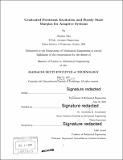| dc.contributor.advisor | Anuradha M. Annaswamy. | en_US |
| dc.contributor.author | Jain, Himani, S.M. Massachusetts Institute of Technology | en_US |
| dc.contributor.other | Massachusetts Institute of Technology. Dept. of Mechanical Engineering. | en_US |
| dc.date.accessioned | 2008-01-10T15:50:20Z | |
| dc.date.available | 2008-01-10T15:50:20Z | |
| dc.date.copyright | 2007 | en_US |
| dc.date.issued | 2007 | en_US |
| dc.identifier.uri | http://hdl.handle.net/1721.1/39877 | |
| dc.description | Thesis (S.M.)--Massachusetts Institute of Technology, Dept. of Mechanical Engineering, 2007. | en_US |
| dc.description | Includes bibliographical references (p. 107-112). | en_US |
| dc.description.abstract | The numerous design tools developed for use with linear controllers, specifically gain and phase margins, do not apply to nonlinear control architectures such as model reference adaptive control. The first step for the development of Verification and Validation (V&V) techniques for this class of nonlinear control systems is presented in this thesis in the context of controlling uncertain flight vehicle dynamics. Using a Reduced Linear Asymptotic System (RLAS), which characterizes the asymptotic behavior of an adaptive system, methods for tuning the free adaptive system parameters such as Lyapunov matrix P to satisfy the desired performance criteria are presented. Making use of the fact that the RLAS is a linear time invariant system, optimization procedures based on output feedback and Linear Matrix Inequalities are proposed. The concept of Persistent excitation in the context of improving stability and robustness properties of closed loop adaptive systems is discussed. Graduated Persistent Excitation (GPE) is introduced as an easy to implement alternative to Persistent excitation. | en_US |
| dc.description.abstract | (cont.) Tools such as MIMO margins based on the singular values of sensitivity matrix are applied on RLAS to systematically derive stability margins of an adaptive flight control system. Additionally, a proof of signal boundedness is presented in the presence of both structured and unstructured uncertainties. The tools are demonstrated on simulations of a nonlinear 6 DoF aircraft model. | en_US |
| dc.description.statementofresponsibility | by Himani Jain. | en_US |
| dc.format.extent | 112 p. | en_US |
| dc.language.iso | eng | en_US |
| dc.publisher | Massachusetts Institute of Technology | en_US |
| dc.rights | M.I.T. theses are protected by copyright. They may be viewed from this source for any purpose, but reproduction or distribution in any format is prohibited without written permission. See provided URL for inquiries about permission. | en_US |
| dc.rights.uri | http://dspace.mit.edu/handle/1721.1/7582 | |
| dc.subject | Mechanical Engineering. | en_US |
| dc.title | Graduated Persistent Excitation and steady state margins for adaptive systems | en_US |
| dc.title.alternative | GPE and steady state margins for adaptive systems | en_US |
| dc.type | Thesis | en_US |
| dc.description.degree | S.M. | en_US |
| dc.contributor.department | Massachusetts Institute of Technology. Department of Mechanical Engineering | |
| dc.identifier.oclc | 181656109 | en_US |
